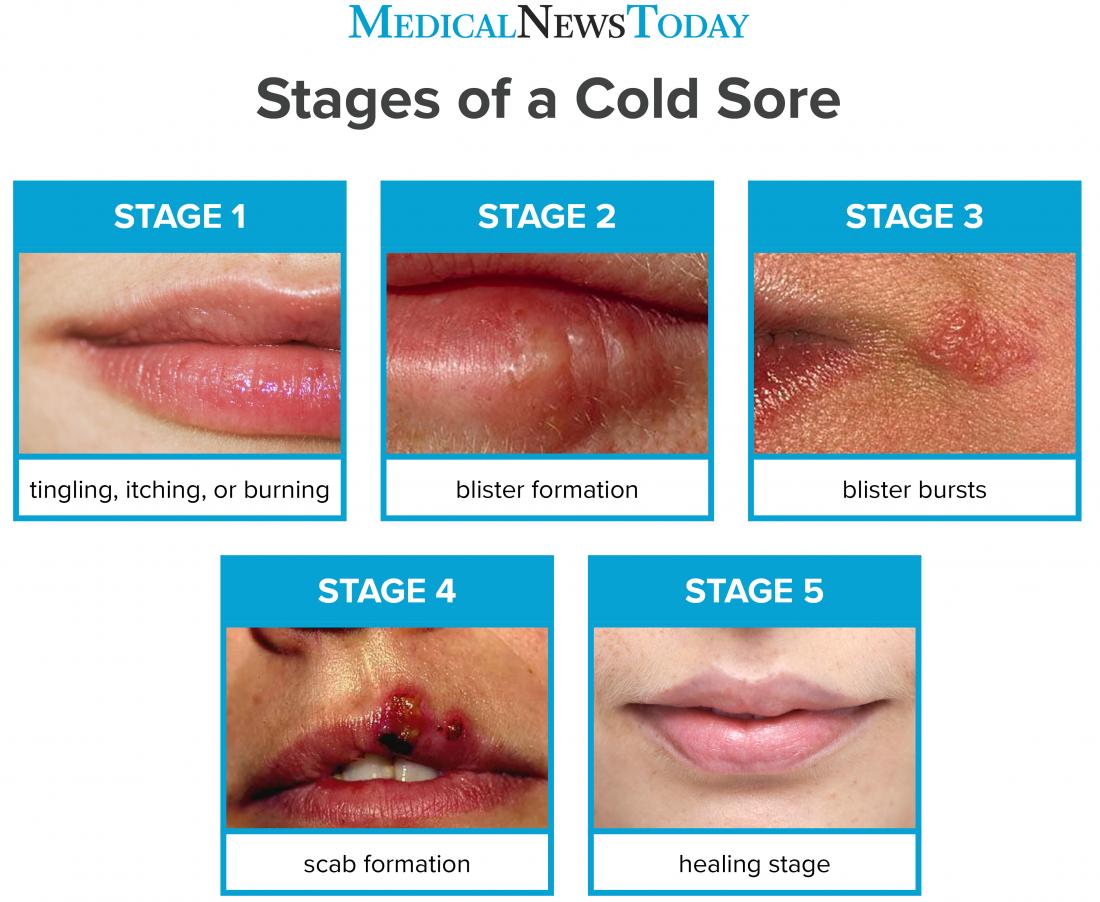There are five stages of cold sores. These lead from the initial tingling in the area to the healing stage.
Cold sores, also known as herpes labialis, are caused by nongenital herpes simplex virus type 1. People can develop a cold sore on their lips or in their mouth.
Transmission of the nongenital herpes simplex virus type 1 (HSV-1) occurs during childhood through nonsexual contact, but adults can contract the infection through sexual activity. HSV-1 hibernates inside skin cells and neurons under the skin until a trigger stimulates it.
Before the cold sore appears, people may feel a burning, stinging, or itching sensation on their lips. For best results, doctors recommend starting treatment as soon as the tingling begins, before the cold sore appears.
In this article, we discuss the stages of a cold sore and what to do if a cold sore develops. We also explore how doctors treat the infection and how people can avoid getting a cold sore.
A cold sore develops in five stages and will typically last between 9 and 12 days.

Stage 1
Initially, people will feel a tingling, itching, or burning sensation underneath the skin around the mouth or base of the nose. Doctors call this the prodrome stage.
Other
- malaise
- fever
- tender or swollen lymph nodes
At this first stage of the cold sore, people will not see a blister. People with recurring cold sores may present milder symptoms. Doctors recommend starting treatment as soon as these symptoms begin.
Treatment for cold sores may include oral or topical medications. Sometimes people will use both types to treat a cold sore.
Oral medications for cold sores include:
- acyclovir (Zovirax)
- famciclovir (Famvir)
- valacyclovir (Valtrex)
Topical treatments for cold sores include:
- acyclovir (Zovirax) cream
- docosanol (Abreva)
- penciclovir (Denavir) cream
Treatment aims to shorten the duration of the cold sore. In
Taking medication when symptoms first appear can prevent or block the cold sore from appearing.
Stage 2
If the person does not use any medication, a fluid-filled blister will likely develop around 1 to 2 days after the initial symptoms.
Stage 3
The third stage, which occurs around day 4, involves the blister opening up and releasing its fluid. Doctors call this stage the ulcer or weeping stage. If another person comes into contact with the blister’s fluid, they may develop a cold sore as well.
Cold sores are contagious and tend to be painful during this stage.
Stage 4
Between days 5 and 8, the cold sore will dry up, leaving a yellow or brown crust. The crust will eventually flake off.
People must take care of the scab during this stage because it can crack or break.
Stage 5
The final stage of a cold sore is the healing stage.
Several scabs may form and flake off during this stage. Every new scab will be smaller and smaller until the wound heals completely. Most often, the cold sore will not leave a scar.
Some doctors suggest that a cold sore can last around
People who come into contact with another person’s cold sore may be at risk of infection. However, they would have to come into contact with the fluid when the blister ruptures.
Some people may develop recurring cold sores. According to the American Family Physician (AAP), various stimuli can awaken the hibernating virus, such as:
- stress
- fever
- sun exposure
- extremes in temperature
- ultraviolet radiation
- a compromised immune system
- injury
When a cold sore enters the ulcer or weeping stage, around the fourth day, the cold sore becomes contagious.
People who come into contact with the fluid from another person’s open blister can develop a cold sore between 2 to 20 days after contact.
People can come into contact with fluid from another person’s cold sore through kissing or sharing utensils, drinkware, cosmetics, or towels.
Doctors suggest that treating a cold sore at the start of symptoms, before the blister appears, may prevent the cold sore from appearing.
People with a history of cold sores can usually detect the initial symptoms and know they need to start treatment right away.
Some people get chronic cold sores and may require preventive treatments. Taking acyclovir or valacyclovir every day may prevent cold sores.
According to the AAP, the recommended doses for each drug are:
- acyclovir 400 milligrams (mg), twice daily
- valacyclovir 500 mg, once daily
People with chronic cold sores will need to take preventive treatments regularly. Also, doctors and dentists recommend:
- eating foods high in lysine, such as red meats, fish, and dairy
- applying sunscreen to the face and lips before going outside throughout the year
- shaving with a disposable razor blade when a cold sore appears
- replacing toothbrushes
- avoiding stress
People should avoid intimate contact with people who have cold sores. Avoid sharing utensils, toothbrushes, towels, and razors.
People with cold sores should avoid touching the blister, and if they do, they need to wash their hands thoroughly.
Cold sores are a common infection of nongenital HSV-1 that people can contract through sexual and nonsexual activities.
People who start treatment when they feel tingling and itching around their lips may block the cold sore from appearing.
If a cold sore appears, it will go through five stages from the prodrome stage to healing. During the ulcer stage, people can transmit the virus to another person. The fluid in the blister contains the virus. People with cold sores must avoid kissing and sharing utensils, towels, and drinkware.
A person may have a cold sore for about 2 weeks, but some doctors suggest that a cold sore can last up to 6 weeks. Medications can help shorten the duration of a cold sore.
